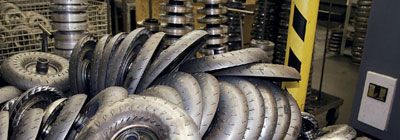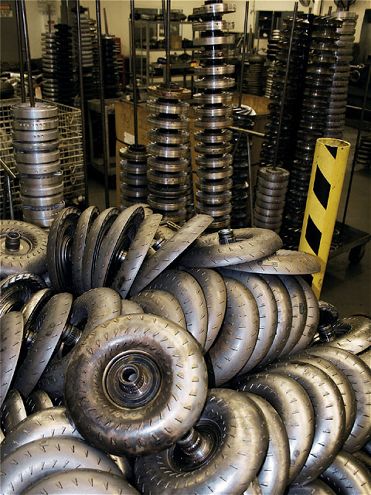

What is a torque converter besides a big round thing used with automatic transmissions that holds a lot of tranny fluid and makes a mess if you spill it? I wasn't sure either; maybe this is due to the fact that I've only owned one or two vehicles out of 15 or 20 that were missing the third pedal and never had any problems with torque converters. I just haven't ever had to cross the converter bridge-until now.
I was unsure of where to start so I called the experts at TCI, B&M, Gear Star, and Phoenix Transmissions to get the straight scoop. Stanley Poff at TCI had this easy analogy to put the torque converter into laymen's terms: "One of the best explanations of this is the two-fan explanation. Set two fans up facing each other and turn one on. As the air starts to move through the fan blades of the fan with no power, the blades start to turn. This is exactly what happens in a torque converter. You can also take a piece of cardboard and redirect the airflow and speed the nonpowered fan blades up or down. We do this in the converter by constructing stators with more or less blades, or by redirecting fluid flow based off of 2 1/2-degree increments of angle in the blades of the stator." Sounds simple enough, huh? There's obviously more science and engineering that goes into a converter, but at least we have a starting point. Let's take a look at the four basic parts that make up a torque converter.
Impeller Pump
We've probably all heard someone refer to the pump in an automatic, which is actually a very simple piece compared to what you may conjure up in your mind. The impeller pump is the outside half (housing) of the converter on the transmission side of the center weld line.
Inside the impeller pump are a series of fins that centrifugally drive the fluid toward its outside diameter and into the turbine. The size of the torque converter (and pump) and the number and shape of the fins all affect the characteristics of the converter. If long torque converter life is an objective, it is extremely important that the fins of the impeller pump are adequately reinforced against fatigue and the outside housing does not distort under stress.
Cover
The cover (aka front) is the outside half of the housing toward the engine side from the center weld line where the cover is welded to the impeller pump.
The cover serves to attach the converter to the flywheel, which is bolted to the engine's crankshaft, and is the other half of what holds in tranny fluid. This cover doesn't serve a performance purpose per se, but it is important that the cover remain rigid under torsional and thrust stress incurred by the tremendous hydraulic pressure generated inside the converter.
Turbine
From the inside, the turbine looks remarkably like the impeller pump. The turbine spins within the confines of the cover and transmits power to the rest of the drivetrain via its splined hub, which the input shaft of the transmission fits into. When the turbine moves, the rear wheels move, whereas when the engine moves, the impeller pump moves with it since it's welded to the cover, which is again attached to the flywheel.
Stator
The stator, which slides onto the input shaft of the transmission and is between the turbine and impeller pump, changes fluid flow between the turbine and pump, in turn multiplying engine torque. The stator looks simple, but the design, size, as well as the number of and angle of its fins dictate how it multiplies engine torque. A torque converter without a stator would not be capable of multiplying torque and would be called a fluid coupler.
The Three Stages Of Torque Converter Operation
Now that we have a basic idea of what's inside a torque converter and their basic functions, let's look at what a torque converter is doing while in use.
Stall
The first of the three stages is stall, and just what is stall, you ask? I didn't know myself and it has always been something that's baffled me (I know I'm not alone). I again turned to Stanley Poff at TCI, who had this to say: "Stall speed is the rpm that a given torque converter (impeller pump) has to spin in order for it to overcome a given amount of load and begin moving the turbine (and in turn the wheels. -Ed). When referring to 'how much stall will I get from this torque converter?', it means how fast (rpm) the torque converter must spin to generate enough fluid force on the turbine to overcome the resting inertia of the vehicle at wide open throttle. Load originates from two places; the first is from the torque imparted on the torque converter by the engine via the crankshaft. Second is from inertia, the resistance of the vehicle to acceleration, which places a load on the torque converter through the drivetrain. This can be thought of as how difficult the drivetrain is to rotate with the vehicle at rest, and is affected by car weight, amount of gear reduction and tire size, ability of the tires to stay adhered to the ground, and the stiffness of the chassis." Boiling what Stanley had to say, we could look at stall as when the trans is in gear, but the brakes stop the vehicle. Under stall conditions and increasing rpm to the converter's stall rating enables the torque converter to multiply the engine torque to its full potential-as shown on the dyno-until the torque exceeds the brake's holding power and the tires start to spin.
Since most V-8 engines make peak torque numbers at lower rpm, that is the area where you want the maximum benefits from stall, so the converter can multiply the engine torque to the max and put that power to the tires.
Generally, a stock converter will have a stall speed of 1,800-2,000 rpm. When you add a mild cam, carb, and so on, or anything that's going to increase the torque of the engine, you want the stall speed to be just above it, not even or below, to reap the full benefits of torque multiplication. People have the misconception that the transmission will slip when rpm drops below the stall speed, but that's not the case. You can have a high stall converter on the street as long as your drivetrain is built to suit and vice versa. Stall also only occurs under full acceleration and not part throttle.
You may hear someone refer to flash stall, which is basically the rpm level the engine reaches when accelerating from a dead stop to when the vehicle begins to move. Of course, there are many options when it comes to picking a stall speed; this is where you need to get on the phone with the manufacturer and discuss your needs with them. You need to be prepared to give them your engine, transmission, rearend, and tire specs as well as vehicle weight if possible and your intended use, so they can get you the right converter. Weight actually has a big effect on converters. Greg Ducato at Phoenix Transmission Products says: "A 2,500-rpm stall speed converter in a T-bucket will probably stall around 1,800 rpm, but put that same converter in a pickup and that'll go up to around 2,800 rpm."
When talking to Gear Star Inc.'s Zack Farah about stall, he had this to offer: "The misconception of stall torque ratio (torque multiplication) is that more must be better. This is not always the case. High stall torque ratio applications are typically for industrial equipment or engines with limited low-rpm engine torque. With high stall torque ratio converters, there are important trade-offs. What you take at one end, you give up on the other. Typically, a torque converter with a very high stall torque ratio, such as 2.0-2.5, will be much less efficient above its rated stall speed. There is a sacrifice in higher rpm efficiency to achieve high stall torque ratios. That lower efficiency translates into less horsepower transmitted to the tires over an rpm range." This reinforces the need to get what you are actually going to use and not the "biggest and baddest."
Acceleration
The acceleration stage is, well, when the vehicle is accelerating. Unfortunately the torque multiplication will drop during this stage. The vehicle will begin moving, but there is a big difference in turbine and impeller pump speeds. This is why drag racers bring up the engine rpm to the optimum stall speed, launch the car, and then increase the engine speed to take advantage of the engine's peak horsepower from there on out.
Under normal driving conditions, your automatic will shift during the optimum stall speed to take advantage of all the "extra" torque made by the transmission.
Coupling
The coupling stage is when the turbine is within about 90 percent of the pump speed. At this point, if your torque converter has a lockup clutch, it would engage and basically fix the turbine and pump together via a small clutch mechanism between the cover and turbine. Under lockup there is no slipping between the two halves of the converter and efficiency inside the converter as well as fuel efficiency goes way up-as much as 65 percent, according to some manufacturers. With today's crazy gas prices, you might wanna upgrade to an overdrive transmission with a lockup converter if you haven't already!
What Else To Look For
Besides stall speed, there are many other factors to consider when buying a torque converter. Most of this has to do with the quality of parts used to build it and efforts taken to make a converter work within and withstand high torque and horsepower applications. Most nonstock converters can be considered performance pieces, and will most likely feature improved construction like furnace-brazed fins in the pump and turbine. An OEM converter has fins that are basically held in place by bending the ends over. If you physically grab one of these fins it will have some movement to it. A quality aftermarket piece should at least have had its fins furnace-brazed in place, which is the first step in the right direction. This will help reduce failure and greatly increases strength since each fin now acts as a gusset in the housing. The next step for increased strength is to actually TIG-weld the fins as much as possible in addition to furnace-brazing.
Another area of concern is to look for improved internal parts like thrust bearings, hubs, and lockup components. While it is common practice to refurbish and improve OE parts such as turbines, covers, and stators, you should be buying a converter that has had its other internal parts upgraded. After all this, look for balloon plates and even billet steel covers on high-performance converters where high pressure and increased heat and rpm are common. This brings us to one last thing to think about-heat. Heat (fluid temperature) is the number-one killer of an automatic transmission and should be taken seriously, especially when you start upgrading your torque converter and/or transmission, but that discussion will be for another month.
Education and help from the pros will be your biggest help in buying the right torque converter, so give them a call and see what your options are!